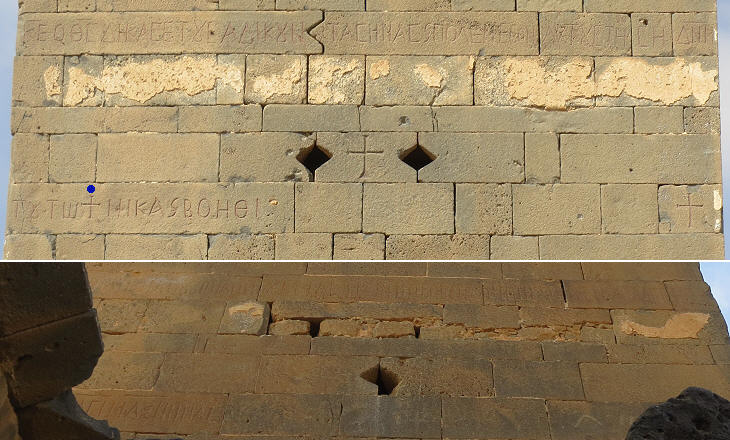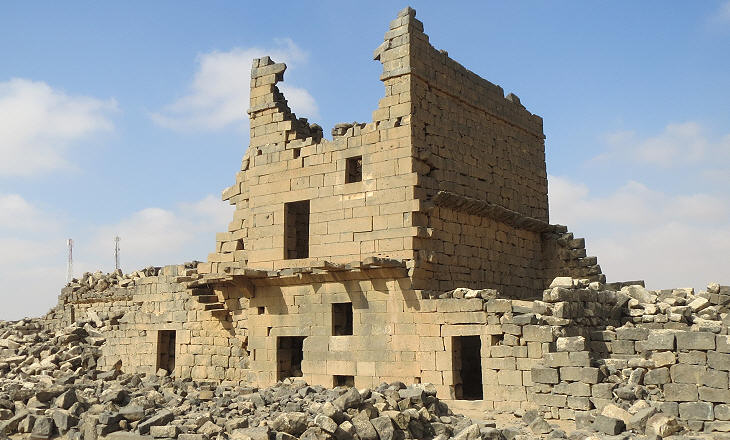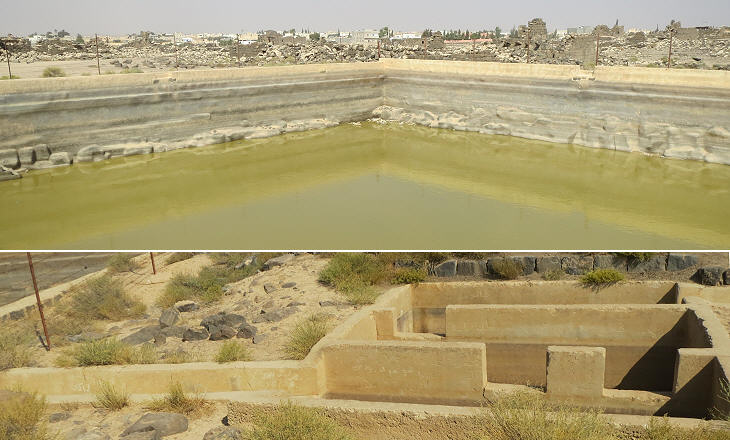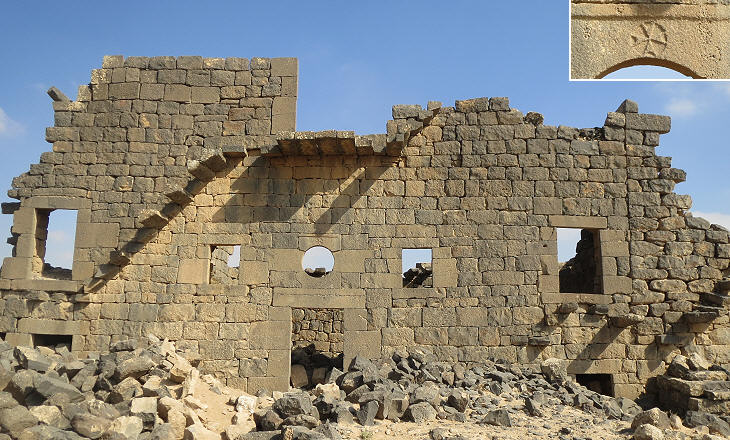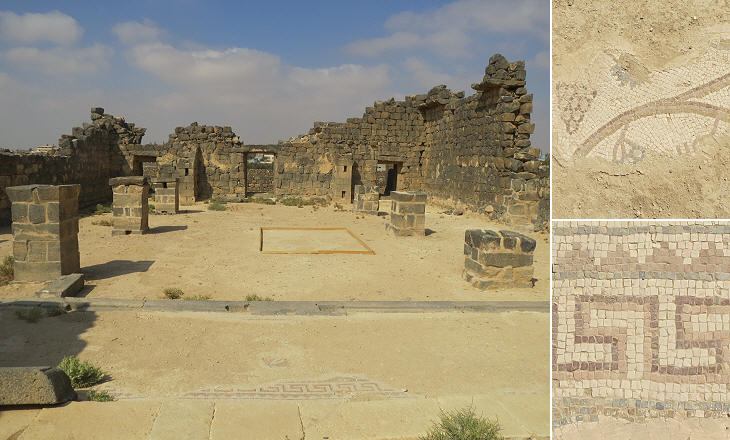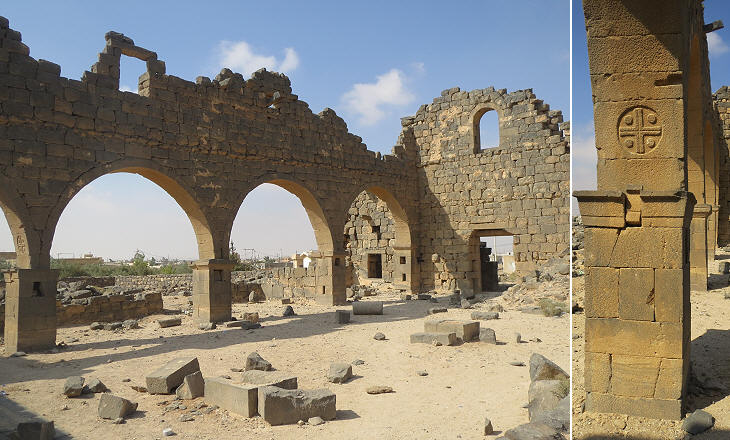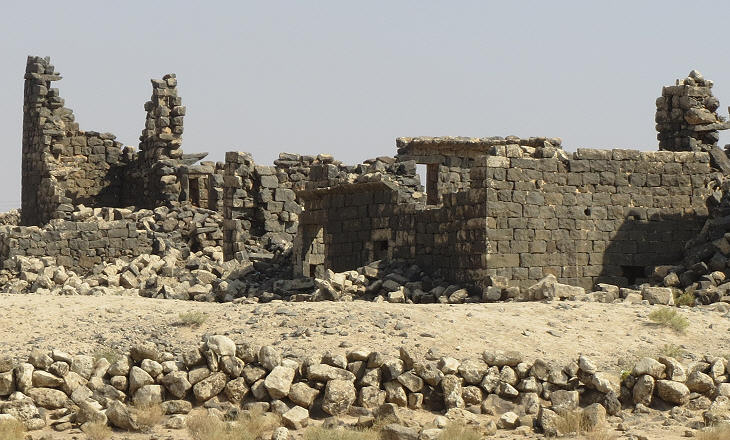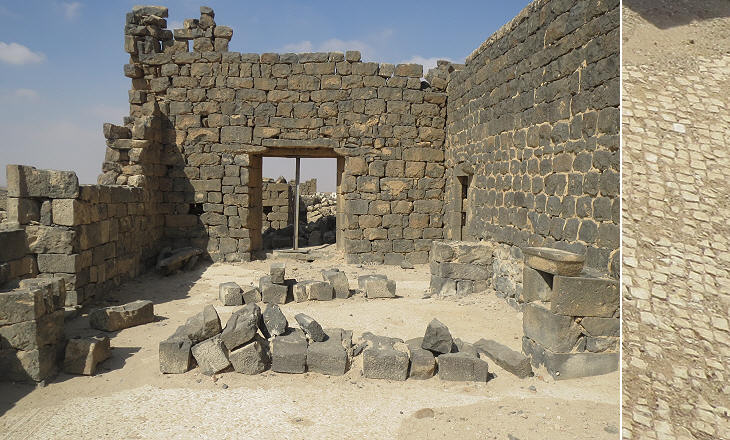  What's New! Detailed Sitemap All images © by Roberto Piperno, owner of the domain. Write to romapip@quipo.it. Text edited by Rosamie Moore. Page added in January 2014. |
 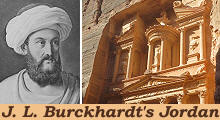 - Umm al-Jimal - Umm al-Jimal(left: J. L. Burckhardt in Arab attire in a XIXth century engraving; right: the Treasury of Petra) April 28th, 1812 - It had been my wish to visit the ruined city of Om El Djemal, which is eight hours distant from Boszra, to the S.; but the demands of the Arabs for conducting me thither were so exorbitant, exceeding even the sum which I had thought necessary to bring with me from Damascus to defray the expenses of my whole journey, that I was obliged to return to Aaere (a village near Suweida, the main centre of the region) towards mid-day, after having offered thirty piastres for a guide, which no one would accept. J. L. Burckhardt - Travels in Syria and the Holy Land - 1822
Umm al-Jimal is situated very near the border between Jordan and Syria. Its name means "Mother of Camels" in Arabic. Burckhardt reports that the Bedouins living in the Hauran region had many camels: The first harvest is that of horse-beans at the end of April: of these there are vast tracts sown, the produce of which serve as food for the cows and sheep. Camels are fed with the flour made from these beans, mixed with barley meal, and made into a paste.
Umm al-Jimal was a Nabatean town which was acquired by the Romans in 106 AD. An inscription found near the site of a lost gate indicates that the walls of the town were strengthened during the reign of Emperor Commodus. By the number of churches and crosses on buildings it appears that the inhabitants of Umm al-Jimal were fervent Christians.
Some archaeological activities were first conducted in 1905-09. More methodical research has been (and still is) done by the team of "Umm al-Jimal Project" (you might wish to see their highly technological website - it opens in another window) with assistance from American foundations and archaeologists. Some parts of the town, however, retain an aspect which gives the visitor the feeling of being like Burckhardt, i.e. the first person to venture into the rubble of its collapsed buildings.
Umm al-Jimal was situated in a very arid environment and an effective water management system was vital for its inhabitants. The basalt rock upon (and of) which the town was built is highly impervious. This made it easy to store water during winter. The large rectangular cistern at the centre of the town however was only a temporary reservoir because its large surface would have caused significant evaporation during the hot season. Many small underground cisterns have been found near the reservoir and in private dwellings where water was stored for long periods.
The Praetorium, the residence of the governor of the town and of the tribunals, was built in 371. It is likely that the cross was carved at that time, although the Christian faith was not yet the official religion of the Roman Empire. This occurred after Emperor Theodosius came to power in 379, but the population of many eastern provinces had already entirely converted and had started to pull down temples and build churches.
In 490 Umm al-Jimal became part of the Ghassanid Kingdom, a buffer state between the Byzantine and the Sassanid (Persian) empires. It was ruled by tribesmen coming from southern Arabia who became Christians and were recognized as foederati (allies) by the Byzantine emperors. In return they granted protection to Byzantine territories from raids by hostile Bedouin tribes and they fought on the side of the Byzantines against the Sassanids. In 566 a large cathedral was built by Al-Harith ibn Jabalah, the Ghassanid king, at Umm al-Jimal.
In the early VIth century the Ghassanids embraced Miaphysitism, usually considered a form of Monophysitism, a theological position which holds that the nature of Jesus Christ is divine only. This view was regarded as heretical by Byzantine Emperor Justinian, but his wife Theodora protected the Monophysites and it does not appear that the Ghassanids were pressed to abandon their views. Justinian's successors however issued decrees against the Monophysites. According to Michael the Syrian, who in the XIIth century wrote a chronicle of world events from Adam until his own time, Byzantine Emperor Heraclius stated: No one should appear in my presence who does not hold the Chalcedonian doctrine (that defined at the Council of Chalcedon, a town on the Asian coast opposite Constantinople, in 451). Moreover, let there be no trial for those who kill, rob and persecute [the Monophysites]. And let them not dare to enter the Church cathedral. Translation by Robert Bedrosian.
Religious rifts among Christians were one of the causes of the success of the Muslims in conquering Palestine, Jordan, Syria and Egypt which were largely Monophysite countries. Most likely the population of Umm al-Jimal continued to be Christian until the town was abandoned in the VIIIth century after a devastating earthquake which struck the region in 747 or 749, because there is not much evidence of its many churches having been turned into mosques as had occurred at Bosra.
Archaeologists believe Umm al-Jimal was used as a basalt quarry for the construction of Qasr al-Hallabat, a small Umayyad residence, and that the long inscription found there came from Umm al-Jimal. The image used as background for this page shows a cross at the Western Church. Move to: Introductory Page Ajlun Castle and Pella (May 3rd, 1812) Amman and its environs (July 7th, 1812) Aqaba "Castles" in the Desert (incl. Qasr el-Azraq) Jerash (May 2nd, 1812) Madaba (July 13th, 1812) Mt. Nebo and the Dead Sea (July 14th, 1812) On the Road to Petra (incl. Kerak and Showbak) (July 14th - August 19th, 1812) Petra (August 22nd, 1812) Umm Qays (May 5th, 1812)  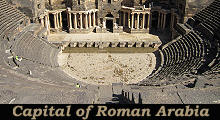  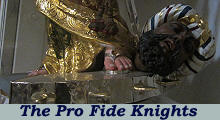
|

